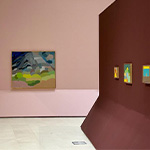The King Abdulaziz Center for World Culture (Ithra) opens Etel Adnan, Between East and West, a major retrospective exhibition showcasing the works of Lebanese-American poet, artist, and philosopher Etel Adnan. One of the most renowned contemporary artists from the region, this is the first solo exhibition of Adnan’s work in Saudi Arabia, running from 1 February – 30 June 2024.
Curated by Dr. Sébastien Delot, formerly Director of LaM (Lille Métropole Musée d’art moderne, d’art contemporain et d’art brut), the exhibition presents Etel Adnan’s creative journey across all periods and mediums of her remarkably diverse career. Thanks to loans from significant international institutions from Sharjah Art Foundation, Sfeir-Semler Gallery and Sursock Museum as well as private collectors, Ithra’s Etel Adnan, Between East and West provides a comprehensive overview of Adnan’s multifaceted artistic practice, delving into the depth and breadth of her connection with the Arab world, culture and language and how she harnessed her creativity to blend her eastern and western cultural influences.
A comprehensive display of 41 of her works spans from the beginning of Adnan’s artistic career in the late 1950s through to her final creations in 2021 before her death, chronicling Adnan’s recourse to art as a multifaceted and elastic tool that allowed for freer creative expression than language. Born in Beirut under French colonial rule, Adnan grew up speaking, and later publishing work written in French rather than Arabic, an abstraction of her Arab identity that the artist addressed by turning to visual art so that she no longer needed to write in French, but could paint in Arabic.
The exhibition opens with a striking 25 square meter ceramic mural, followed by a screening of Motion which is a montage of several Super 8 films made by Etel Adnan in Yosemite, New York and San Francisco in the 1980s.
Among the showcased works are Adnan’s iconic hand-woven wool tapestries, inspired by Persian rugs of her childhood and the Arab tradition of woven craft, where threads interlace to create vibrant stories suspended in time and to reflect the artist’s mastery in color as language.
Alongside these are Adnan’s ‘Leporellos’, a distinctive form of accordion-folded artist books of Japanese origin. These unfold to reveal an intimate dialogue between visual and written languages, as well as a close connection between the artist’s western and Arab influences. Adnan harnessed this format to present visual interpretations of poems by great contemporary Arab writers, combining both across each fold, inviting the viewer to embark on a simultaneous literary and visual journey.
Also included is a wide array of oil and watercolor pieces – abstract, elemental works in which Adnan’s masterful handling of color radiates from the canvas. These works, ranging from the bold strokes of oil to the delicate nuances of watercolor, showcase Adnan’s ability to transcend borders and cultures through her distinctive visual language.
From the vibrant exuberance of her early works to the contemplative depths of her recent pieces, this exhibition presents the fluidity of Adnan’s artistic expression, in which she found a home—a universal language that accommodated all the facets of her identity, that resonates as powerfully to this day. The threads of her biography are woven with the vibrant hues of her diverse experiences across countries, reflecting a life lived between languages, cultures, and the enduring allure of the sun and sea. A multicultural artist par excellence, bridging eastern and western influences, this exhibition contributes to Ithra’s commitment to programming that promotes cross-cultural exchange and understanding.
The exhibition’s catalogue, published by Hatje Cantz in both Arabic and English, will feature contributions from Sébastien Delot, alongside art historian, writer and poet Toni Maraini and art historian, publisher and curator Morad Montazami.
Farah Abushullaih, Head of Museum at Ithra, said: “Etel Adnan, Between East and West presents a wonderful opportunity to spotlight Etel Adnan, a key figure in global contemporary art, whose identity and work are deeply rooted in the Arab world and its rich heritage. As a versatile artist, Adnan seamlessly navigated between the realms of written and visual arts, with Arabic scripture acting as a bridge between the two, a motif that Adnan was particularly drawn to. Through this exhibition, Ithra continues its commitment to introduce significant artists to Saudi audiences, shedding light on their impactful artistic contributions, further inspiring and invigorating the Kingdom’s creative landscape.”
Dr. Sébastien Delot, former Director of LaM (Lille Métropole Musée d’art moderne, d’art contemporain et d’art brut): “I am honoured to have had the opportunity to work closely with Ithra to curate the first retrospective exhibition of Etel Adnan’s work in Saudi Arabia. A beloved artist whose works – both written and visual – resonate with so many audiences across the globe, I’m thrilled that such a wide breadth of Adnan’s works will be brought to Saudi audiences, further widening the reach of her oeuvre, particularly within a region that was so significant to Adnan personally and professionally. Her works beautifully resonate with the Saudi landscape, creating cross-cultural connections that embody a modernity that transcends boundaries.”
Press release from The King Abdulaziz Center for World Culture (Ithra)
Image: Etel Adnan. Installation view of Etel Adnan, Between East and West at The King Abdulaziz Center for World Culture (Ithra), Dhahran, 2024. Image courtesy of The King Abdulaziz Center for World Culture (Ithra)



